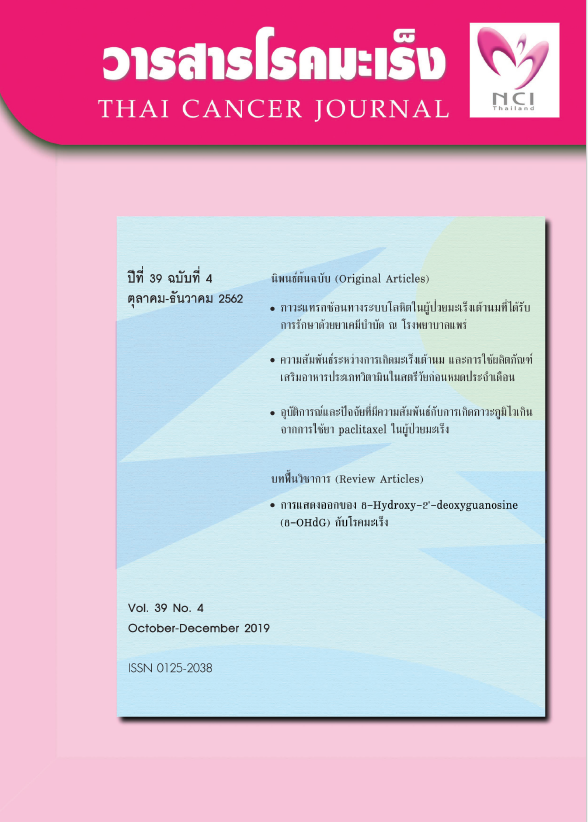Relationship between Breast Cancer and Vitamin Supplement Use in Premenopausal Women
Keywords:
vitamin supplements, premenopausal women, breast cancer, case-control studyAbstract
Hematological toxicity related to bone marrow suppression is a common treatment complication of patients undergoing chemotherapy. This may cause dose adjustment, delay treatment, or hospitalization, leading to diminished treatment efficacy, clinical status and quality of life. The objective of this descriptive retrospective study was to examine the incidence and severity of hematologic toxicity among breast-cancer patients undergoing chemotherapy. Two hundred and twenty (220) patients underwent chemotherapy at the Chemotherapy Unit, Phrae Hospital, between January 2012 and December 2016. Data collected from patients' records were reviewed for hematological toxicity, comprising anemia, leukopenia, neutropenia, and thrombocytopenia. The incidence and severity of hematological toxicity were analyzed. The findings showed that the highest incidence of anemia was observed in 100% of patients treated with docetaxel and paclitaxel protocols, with leukopenia and neutropenia of 100% and 64.71%, respectively, among patients treated with the paclitaxel protocol. The lowest incidence of thrombocytopenia was found in 11.76% of cases treated with the paclitaxel protocol. The severity of hematological toxicity varied significantly across chemotherapy regimens; the highest severity of anemia (grade 3) was observed among patients treated with the fluorouracil, doxorubicin (Adriamycin), and cyclophosphamide (FAC) and AC protocols, with grade 3 leukopenia in FAC and paclitaxel protocols; both grade 4 neutropenia and grade 3 thrombocytopenia were observed among patients treated with the FAC protocol. It is suggested that hematologic-toxicity complications should be examined regularly and cautiously for breast-cancer patients undergoing chemotherapy
References
World Health Organization. NCD Management Unit. Cancer. World cancer today 2019. Available from: https://www.who.int/cancer/en/. Accessed July 11, 2019.
Imsamran W, Supattagorn P, Chiawiriyabunya I, Namthaisong K, Pattatang A, Wongsena M, et al. Cancer in Thailand IX, 2013-2015. Bangkok.
Sun YS, Zhao Z, Yang ZN, Xu F, Lu HJ, Zhu ZY, et al. Risk Factors and Preventions of Breast Cancer. Int J Biol Sci 2017;13:1387-97.
เสกสรรค์ วีระสุข และวรางคณา อดิศรประเสริฐ. การศึกษาพฤติกรรมผู้บริโภคผลิตภณัฑ์เสริมอาหารประเภทวิตามินในกรุงเทพมหานคร. วารสารบริหารธุรกิจ ศรีนครินทรวิโรฒ 2557;5:65-79.
Larsson SC, Akesson A, Bergkvist L, Wolk A. Multivitamin use and breast cancer incidence in a prospective cohort of Swedish women. Am J Clin Nutr 2010;91:1268-72.
นาฏอนงค์ นามบุดดี. อนาคตของผลิตภัณฑ์เสริมอาหารและการปรับกลยุทธ์การตลาดในไทย. วารสารสังคมศาสตร์ มหาวิทยาลยัศรีนครินทรวิโรฒ 2558;18:353-74.
Moorman PG, Ricciuti MF, Millikan RC, Newman B. Vitamin supplement use and breast cancer in a North Carolina population. Public Health Nutr 2001;4:821-7.
Gaziano JM, Sesso HD, Christen WG, Bubes V, Smith JP, MacFadyen J, et al. Multivitamins in the prevention of cancer in men: the Physicians’ Health Study II randomized controlled trial. JAMA 2012;308:187180.
Morales L, Alvarez-Garriga C, Matta J, Ortiz C, Vergne Y, Vargas W, et al. Factors associated with breast cancer in Puerto Rican women. J Epidemiol Glob Health 2013;3:205-15.
Shamsi U, Khan S, Usman S, Soomro S, Azam I. A multicenter matched case control study of breast cancer risk factors among women in Karachi, Pakistan. Asian Pac J Cancer Prev 2013;14:183-8.
Schlesselman JJ. Case-Control Studies: Design, Conduct, Analysis: Design, Conduct, Analysis. New York, USA: Oxford University Press; 1982. p. 144-53.
Brinton LA, Daling JR, Liff JM, Schoenberg JB, Malone KE, Stanford RJ, et al. Oral contraceptives and breast cancer risk among younger women. J Natl Cancer Inst 1995;87:827-35.
Global Strategy on Diet, Physical Activity and Health: Physical Activity and Adults. Available from: http://www.who.int/diet/index.html. Accessed July 11, 2019.
Rithirangsriroj K, Panyakhamlerd K, Chaikittisilpa S, Chaiwatanarat T, Taechakraichana N. Osteoporosis in different age-groups and various body mass index (BMI) range in women undergoing bone mass measurement at King Chulalongkorn Memorial Hospital. J Med Assoc Thai 2012;95:644-9.
Huang HY, Caballero B, Chang S, Alberg A, Semba R, Schneyer C, et al. Multivitamin/mineral supplements and prevention of chronic disease. Evid Rep Technol Assess 2006;139:1-117.
Greenwald P, Anderson D, Nelson SA, Taylor PR. Clinical trials of vitamin and mineral supplements for cancer prevention. Am J Clin Nutr. 2007;85:314-7.
Pan SY, Zhou J, Gibbons L, Morrison H, Wen SW. Antioxidants and breast cancer risk-a population-based case-control study in Canada. BMC Cancer 2011;11:372-84.
ประสงค์ เทียนบุญ. บทบาทของสารต้านอนุมูลอิสระกับสุขภาพ. วารสารคลินิกอาหารและโภชนาการ 2553;4: 69-76
Vergne Y, Matta J, Morales L, Vargas W, Alvarez- Garriga C, Bayona M. Breast Cancer and DNA Repair Capacity: Association With Use of Multivitamin and Calcium Supplements. Integr Med 2013;12:38-46.
Dorjgochoo T, Shrubsole MJ, Shu XO, Lu W, Ruan Z, Zheng Y, et al. Vitamin supplement use and risk for breast cancer: the Shanghai Breast Cancer Study. Breast Cancer Res Treat 2008;111:269-78.
Nissen SB, Tjonneland A, Stripp C, Olsen A, Christensen J, Overvad K, et al. Intake of vitamins A, C, and E from diet and supplements and breast cancer in postmenopausal women. Cancer Causes Control 2003;14:695-704.
Downloads
Published
Issue
Section
License
บทความทีตีพิมพ์ในวารสารโรคมะเร็งนี้ถือว่าเป็นลิขสิทธิ์ของมูลนิธิสถาบันมะเร็งแห่งชาติ และผลงานวิชาการหรือวิจัยของคณะผู้เขียน ไม่ใช่ความคิดเห็นของบรรณาธิการหรือผู้จัดทํา







